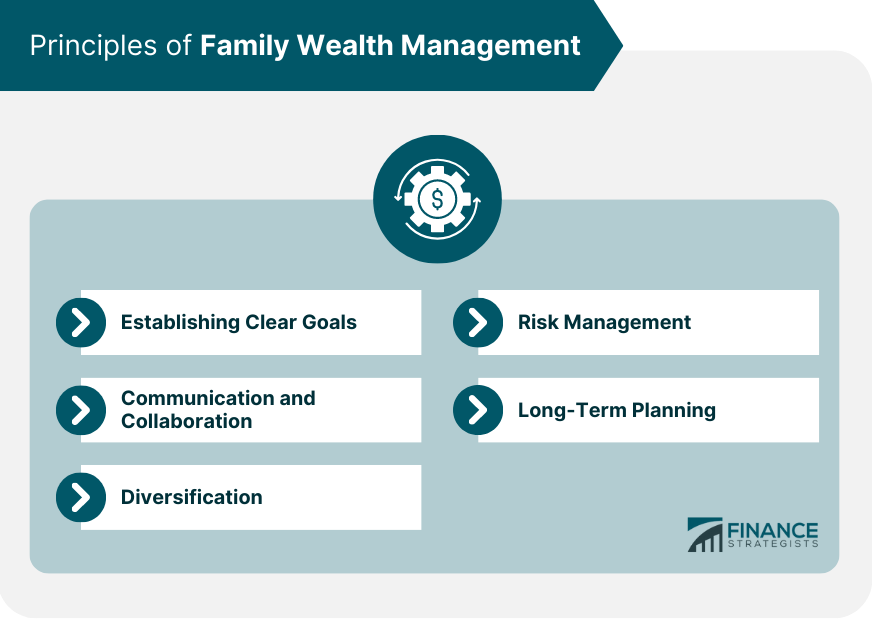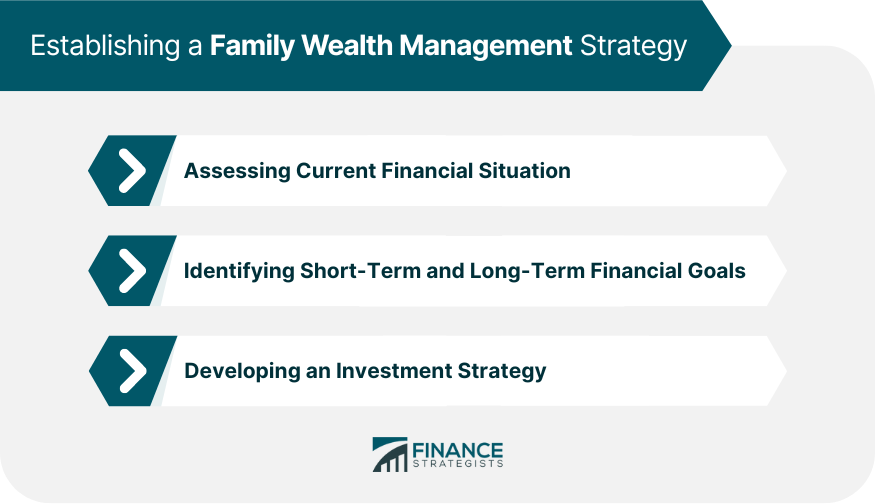Family wealth management is the process of preserving, growing, and transferring wealth within a family across generations. It encompasses a wide range of activities, including investment management, estate planning, tax planning, philanthropy, and succession planning. Family wealth management is essential for ensuring that family assets are protected, optimized, and passed down to future generations according to the family's goals and values.
Defining specific, measurable, achievable, relevant, and time-bound (SMART) financial goals is the foundation of effective family wealth management. Clear goals enable family members to work collaboratively towards common objectives and facilitate decision-making regarding investments, risk tolerance, and other aspects of wealth management. Open and honest communication among family members is crucial for successful wealth management. Regular family meetings, discussions, and updates help maintain transparency, build trust, and foster cooperation. Collaboration enables the family to make informed decisions and ensure all members are aligned with the family's financial goals and values. Diversification is a key principle in family wealth management, as it helps to spread risk across various investments and asset classes. This approach can reduce the potential impact of underperforming investments and safeguard family wealth from market fluctuations and economic downturns. Managing risk is essential to protect and grow family wealth. By understanding and considering the family's risk tolerance, financial advisors can develop appropriate investment strategies and recommend suitable asset allocations. Additionally, risk management can involve implementing strategies like insurance coverage, asset protection planning, and contingency plans for unforeseen events. Family wealth management requires a long-term perspective, as it aims to preserve and grow wealth over generations. This approach involves prioritizing long-term investments, focusing on sustainable growth, and considering the implications of financial decisions on future generations. A comprehensive assessment of the family's current financial situation is necessary to establish a wealth management strategy. This involves calculating net worth, analyzing cash flow, and addressing debt management. Understanding the family's financial position helps to identify areas for improvement and serves as a starting point for setting financial goals. Once the family's financial situation is understood, it's essential to identify both short-term and long-term financial goals. Short-term goals may include funding education, purchasing a home, or reducing debt, while long-term goals could involve retirement planning, wealth transfer, and philanthropy. An effective investment strategy considers asset allocation, portfolio diversification, tax efficiency, and risk tolerance. Asset allocation involves distributing investments across various asset classes, such as stocks, bonds, and real estate. Diversification reduces risk by spreading investments across different industries, sectors, and regions. Tax efficiency ensures that investments are structured to minimize tax liabilities, and risk tolerance guides the level of risk the family is willing to assume. A family wealth management team consists of family members and professional advisors, such as financial advisors, attorneys, and accountants. Family members are responsible for setting goals, providing input on decisions, and ensuring that wealth management aligns with their values. Professional advisors offer expertise and guidance in their respective fields, helping to implement and manage the family's wealth management strategy. When choosing professional advisors, families should consider their experience, qualifications, fees, and compatibility with the family's values and goals. Experienced and qualified advisors can provide valuable insights and advice, while fee structures should be transparent and reasonable. It's essential to select advisors who understand and respect the family's values and goals, as they will play a critical role in shaping and executing the wealth management strategy. Estate planning is a vital component of family wealth management, as it ensures that assets are distributed according to the family's wishes upon the death of a family member. Proper estate planning helps to minimize taxes, protect assets from creditors, and provide financial security for surviving family members. Estate planning involves several tools, such as wills, trusts, powers of attorney, and beneficiary designations. Wills outline how assets will be distributed upon death, while trusts can provide additional control over asset distribution and offer tax advantages. Powers of attorney designate someone to make financial and medical decisions on behalf of an individual in case of incapacity. Beneficiary designations on financial accounts and insurance policies specify who will receive assets upon the account holder's death. Wealth transfer can result in significant tax liabilities, such as estate taxes and inheritance taxes. Strategies for minimizing estate taxes include gifting assets during one's lifetime, establishing trusts, and utilizing life insurance policies. Families should consult with tax professionals to optimize their estate planning and minimize potential tax burdens. Philanthropy can be an integral part of a family's wealth management strategy, as it allows families to give back to society and create a lasting impact. Including philanthropy in wealth management can also provide tax benefits and create a sense of purpose and fulfillment for family members. There are various charitable giving vehicles that families can use to support their philanthropic goals. Donor-advised funds allow families to make tax-deductible donations to a fund and recommend grants to charities over time. Private foundations offer greater control over grant-making but require more administration and oversight. Charitable trusts, such as charitable remainder trusts and charitable lead trusts, can provide tax benefits and enable families to support their favorite causes while preserving assets for heirs. To ensure that their philanthropic efforts are effective, families should measure the social impact of their giving. This can involve tracking outcomes, assessing the performance of supported organizations, and evaluating the alignment of philanthropic activities with the family's values and goals. Succession planning is crucial for the continuity of family businesses and the preservation of family wealth. A well-prepared succession plan outlines the process of transferring ownership and control of assets, businesses, and other entities to future generations, ensuring a smooth transition and minimizing potential conflicts. Creating a succession plan involves identifying potential successors, preparing them for leadership roles, and outlining the process for transitioning ownership and control. This process may include leadership training, mentorship, and gradual involvement in the management of the family's assets and businesses. Family governance structures, such as family meetings, family councils, and family constitutions, help establish a framework for decision-making and communication within the family. These structures promote transparency, accountability, and collaboration, contributing to the success of the family's wealth management efforts. It is essential to conduct regular financial reviews to monitor the progress of the family's wealth management plan. These reviews help identify any deviations from the plan, assess the performance of investments and advisors, and determine whether adjustments are needed. Family circumstances can change over time, such as the addition of new family members, changes in personal financial situations, or shifts in the family's values and goals. Adapting the family wealth management plan to these changes is essential to ensure its continued effectiveness and alignment with the family's evolving needs and objectives. Periodically evaluating the performance of investments and advisors helps to ensure that the family's wealth is being managed effectively. This process involves assessing the returns and risks of the investment portfolio, comparing them with relevant benchmarks, and determining whether the family's advisors are meeting expectations. Estate and succession plans should be reviewed and updated regularly to reflect changes in family circumstances, tax laws, and the family's goals. Regular updates ensure that these plans remain relevant and effective in protecting the family's wealth and facilitating its transfer to future generations. Family wealth management is a dynamic and continuous process that plays a pivotal role in preserving, growing, and transferring wealth across generations. Establishing clear goals, promoting open communication and collaboration, and assembling a competent wealth management team are essential components to achieve financial objectives and maintain family values. A comprehensive wealth management strategy encompasses investment management, estate planning, tax planning, philanthropy, and succession planning, ensuring that family assets are protected, optimized, and aligned with the family's vision and objectives. Adapting to changing circumstances and seizing new opportunities are crucial for the ongoing success of family wealth management efforts. By regularly reviewing and updating estate and succession plans, evaluating the performance of investments and advisors, and adjusting the wealth management plan to reflect changes in family circumstances and goals, families can ensure the continued effectiveness of their strategies. This proactive and forward-looking approach to family wealth management lays the foundation for a lasting legacy that benefits current and future generations.What Is Family Wealth Management?
Principles of Family Wealth Management
Establishing Clear Goals
Communication and Collaboration
Diversification
Risk Management
Long-Term Planning

Establishing a Family Wealth Management Strategy
Assessing Current Financial Situation
Identifying Short-Term and Long-Term Financial Goals
Developing an Investment Strategy

Building a Family Wealth Management Team
Roles and Responsibilities
Selecting Professional Advisors
Estate Planning and Wealth Transfer
Importance of Estate Planning
Tools for Estate Planning
Tax Implications of Wealth Transfer
Philanthropy and Social Impact in Family Wealth Management
Incorporating Philanthropy in Wealth Management
Types of Charitable Giving Vehicles
Measuring the Social Impact of Philanthropy
Succession Planning and Family Governance
Importance of Succession Planning
Developing a Succession Plan
Family Governance Structures
Monitoring and Adjusting the Family Wealth Management Plan
Regular Financial Reviews
Adapting to Changes in Family Circumstances
Evaluating the Performance of Investments and Advisors
Updating Estate Plans and Succession Plans
Conclusion
Family Wealth Management FAQs
Family wealth management refers to the process of managing the financial assets of a family, including investments, real estate, business interests, and other assets. The primary goal of family wealth management is to preserve and grow wealth across generations while taking into account the family's unique needs and goals.
Family wealth management typically includes investment management, tax planning, estate planning, philanthropy, risk management, and financial education. Wealth managers work closely with their clients to develop personalized strategies to help them achieve their financial goals and protect their wealth.
A family office is a private wealth management advisory firm that provides comprehensive financial services to high-net-worth families. The family office may oversee all aspects of the family's financial affairs, including investments, tax planning, estate planning, philanthropy, and risk management. The family office serves as a central hub for the family's financial activities, helping to coordinate and manage the various service providers involved.
Family wealth management can be complex and challenging due to the many unique factors involved, such as family dynamics, multiple generations, and complex financial structures. It can be difficult to balance the needs and goals of various family members and stakeholders while also ensuring that the wealth is preserved and grown over time.
Family wealth management is important for several reasons. It helps families to preserve and grow their wealth across generations, providing financial security and stability for future generations. It also allows families to make a positive impact through philanthropy and social responsibility initiatives. Effective wealth management can also help families to achieve their personal and financial goals, such as funding education, supporting a business, or pursuing a specific lifestyle.
True Tamplin is a published author, public speaker, CEO of UpDigital, and founder of Finance Strategists.
True is a Certified Educator in Personal Finance (CEPF®), author of The Handy Financial Ratios Guide, a member of the Society for Advancing Business Editing and Writing, contributes to his financial education site, Finance Strategists, and has spoken to various financial communities such as the CFA Institute, as well as university students like his Alma mater, Biola University, where he received a bachelor of science in business and data analytics.
To learn more about True, visit his personal website or view his author profiles on Amazon, Nasdaq and Forbes.











